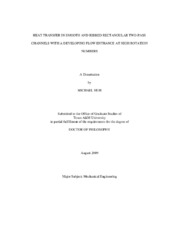| dc.description.abstract | Cooling channels with a developing flow entrance condition and aspect ratios of
1:4 and 2:1 were studied. The range of the rotation number and buoyancy parameter for
the selected AR channels was extended. The maximum Ro and Bo for the 1:4 channel
was 0.67 and 1.9, respectively. For the 2:1 channel, these values were 0.45 and 0.85,
respectively.
The effect of rib spacing and rib height on heat transfer in the 1:4 channel is
investigated. Three rib spacing configurations were considered: P/e=2.5, 5, 10 with a
constant e/Dh ratio of 0.078. To investigate the effect of rib height, a rib configuration
with an e/Dh ratio of 0.156 and P/e ratio of 10 was considered. For the 2:1 channel, a
smooth channel surface condition was studied. For each channel aspect ratio and surface
condition, five Reynolds numbers were studied up to 40K. At each Re, five rotational
speeds are considered up to 400 rpm.
The results of this research work indicate that rotation can cause a significant
increase in heat transfer on the first pass trailing surface of both aspect ratio channels. The leading surface in ribbed channels has shown a dramatic decrease in heat transfer
with rotation in the first pass. Reductions in heat transfer by as much as 50% were
observed. In the second pass, the leading and trailing surfaces with ribs showed very
similar effects of rotation. Also, the effect of rotation seems to vary with the rib spacing.
The strength of rotation showed to be greater in the tight rib spacing of P/e=2.5. The rib
height in the 1:4 channel had minimal impact due to the large distance between the
leading and trailing surfaces. The tip cap heat transfer for both channels showed large
increases with rotation. This is very beneficial since tip cooling is an important part of
maintaining the life a turbine blade. Finally, the buoyancy parameter proved to be very
useful in predicting heat transfer in rotating conditions. The correlations developed
showed very acceptable accuracy when compared to the experimental data. | en |


